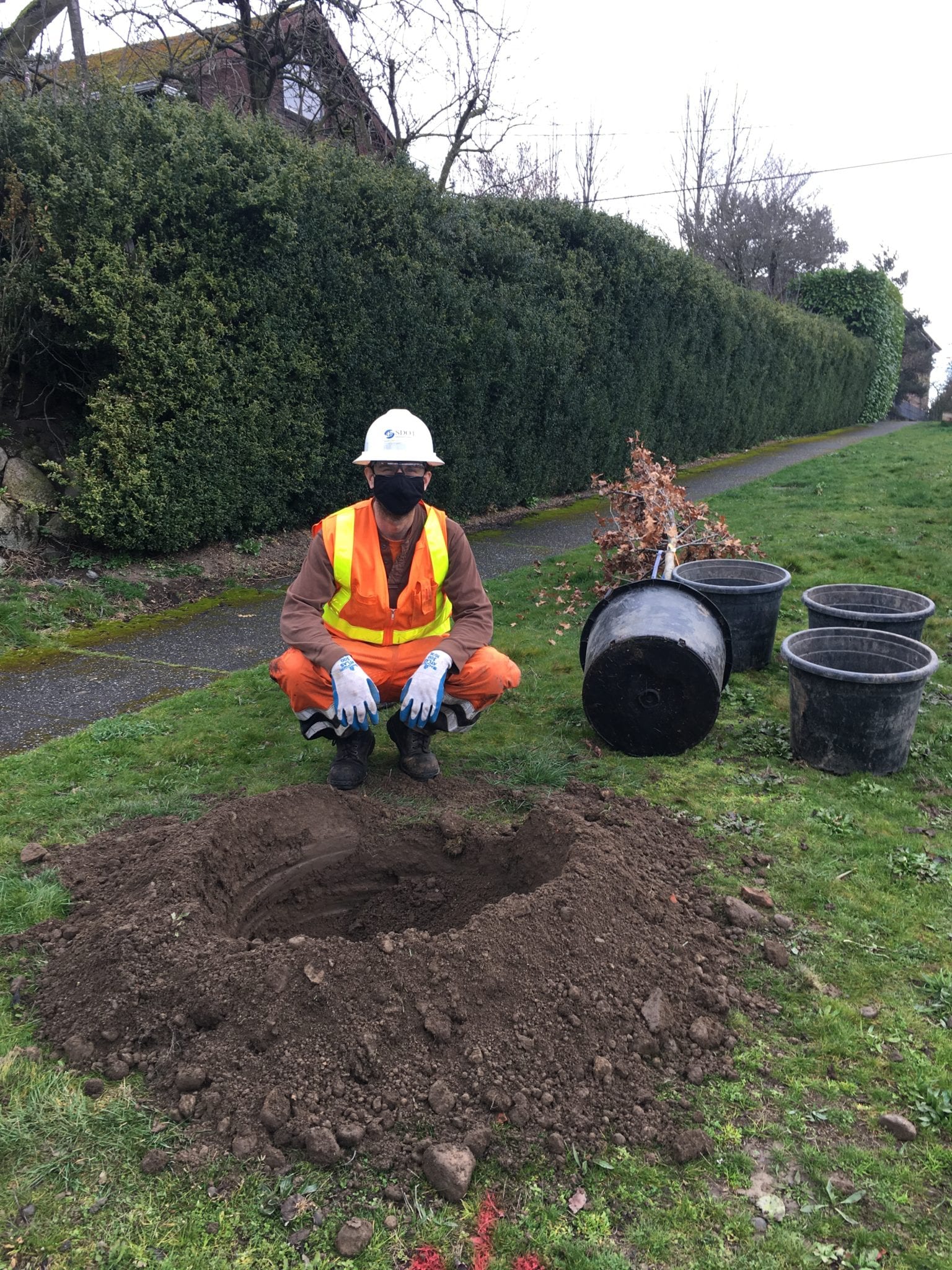 SDOT crew member gets ready to plant a new tree in South Park. Photo: Sherry Graham
SDOT crew member gets ready to plant a new tree in South Park. Photo: Sherry Graham Summary
- Trees make our city healthier, safer, and more pleasant. SDOT’s Tree and Landscaping Program works to maintain, protect, and expand Seattle’s urban landscape.
- Black, Indigenous, and People of Color (BIPOC) in Seattle are more likely to experience environmental inequities and injustices. Communities in the Duwamish Valley have historically experienced higher levels of pollution and worse health outcomes than other neighborhoods in the city.
- We’re working to create safe and walkable neighborhoods for people of all ages and abilities, design plans that calm traffic and maintain local access, and improve residents’ quality of life and strengthen community through Reconnect West Seattle Home Zones.
- Our team responded to community concerns and planted about 40 new trees in the South Park neighborhood!
- The Duwamish Valley Youth Corps were valuable partners on this project, helping us engage with residents in the community.
Spring is here! To celebrate, we are bringing you stories about trees on the blog. Check out our first Foliage Week blog post about a new Tree Selection Guidance Tool that can help you identify the right tree to plant.
Trees are a key ingredient of a healthy, sustainable, thriving city. Trees improve the quality of the air that we breathe, soak up rainwater (keeping our streams, lakes, and Puget Sound clean), calm traffic, make our streets friendly for people walking, rolling, and biking, and provide a variety of social and human health benefits.
SDOT maintains 40,000 of Seattle’s estimated 250,000 street trees. Explore our map of street trees here!
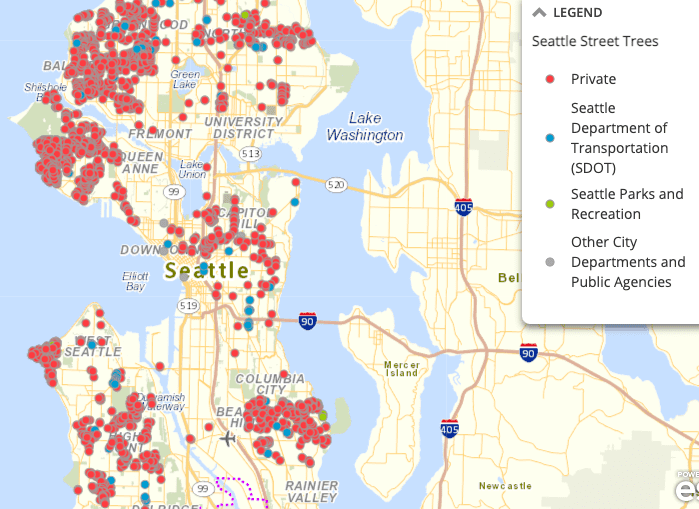
Canopy cover—the percent of the city covered by trees from an aerial view—is an important tool for the City to understand how trees are distributed around Seattle. Seattle currently has 28 percent canopy cover, and a goal to reach 30 percent canopy cover by 2037. The Urban Forest Stewardship Plan guides the City’s progress towards that goal.
Some parts of Seattle enjoy the benefits of trees more than others. Seattle’s 2016 canopy cover assessment found that more BIPOC people tend to live in the census tracts with lower amounts of tree canopy. Seattle’s work to protect the climate and our environment is also a fight for social justice.
Communities in the Duwamish Valley have historically experienced higher levels of pollution and worse health outcomes than other neighborhoods in the city.
The Duwamish Valley boasts a diversity of cultures and a strong sense of identity but also faces social, racial, health, environmental, and economic challenges at a magnitude far greater than the Seattle community as a whole. Public health studies, data from the EPA, and the City’s Environmental Equity Assessment find that exposure to air pollution, noise pollution, and highways is higher in the Duwamish Valley than the city average and that the distribution of environmental benefits such as access to open space and access to healthy and culturally appropriate food is lower.
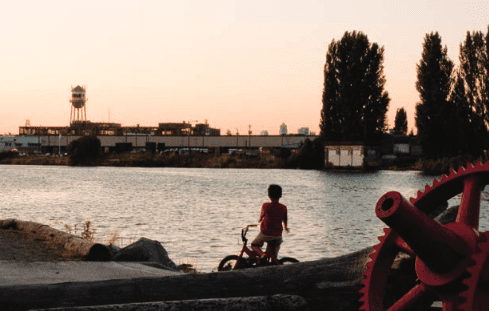
The Duwamish Valley Action Plan is a City-community shared vision that aims to advance environmental justice and equitable development, address racial and neighborhood-level disparities, reduce health inequities, build community capacity, create stronger economic pathways and opportunity, and build trust in government.
When the West Seattle High-Rise Bridge closed to traffic in March 2020, these communities faced new challenges.
The unexpected closure of the West Seattle High-Rise Bridge dramatically affected Duwamish Valley communities. In 2020, we launched Reconnect West Seattle, a framework for supporting neighborhoods impacted by the closure of the West Seattle High-Rise and restoring efficient travel across the Duwamish.
We established Reconnect West Seattle Home Zones to create safe and walkable neighborhoods for people of all ages and abilities, design plans that calm traffic and maintain local access, and improve residents’ quality of life and strengthen community. We worked with communities from South Park, Georgetown, and Highland Park to identify improvements that we could make.
South Park residents brought forward their concerns about air pollution, heat zones, and the lack of trees in the neighborhood, particularly along S Henderson and 7th Ave S. We consulted with our urban forestry experts and came up with a plan to plant new trees!
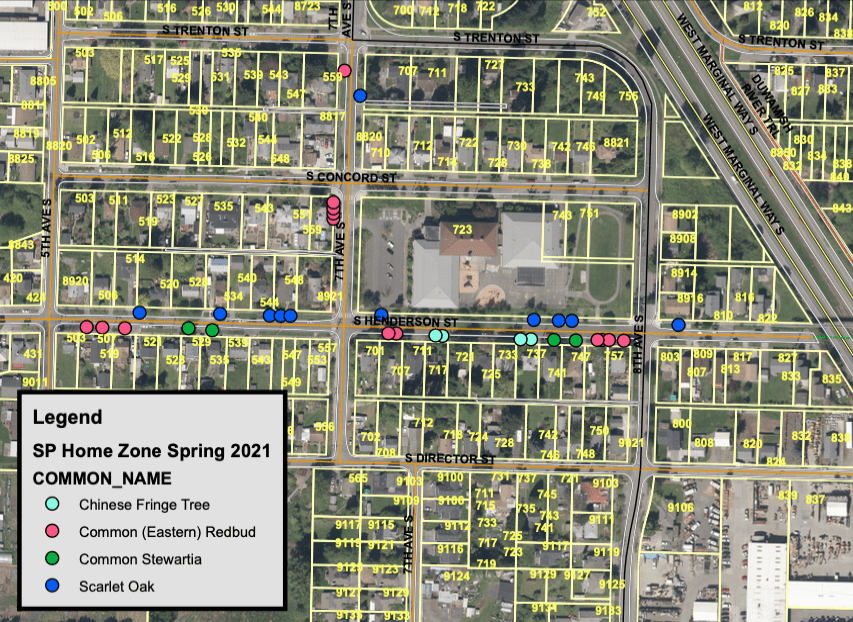
We chose trees that intermingle well with existing trees and are relatively easy to maintain. On March 19th and 20th, our Urban Forestry team got to work, planting about 40 trees. They have a few more trees to plant and will finish the project this week.
These new trees are owned and maintained by the City of Seattle, which means that we are responsible for watering and replacing a tree if it dies. We placed a water bag on each tree and our teams will water the tree once a week during the summer for the next 3-5 years.
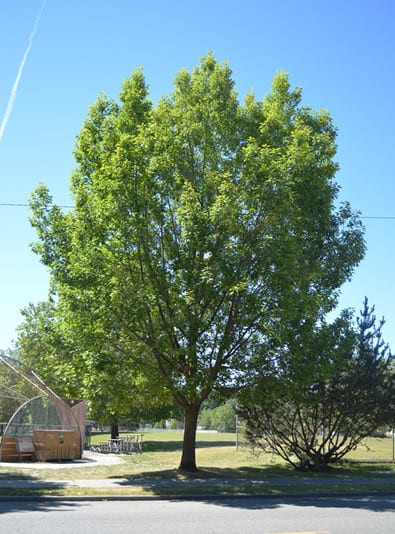
In areas without power lines overhead, we planted mature Scarlet Oak trees. Scarlet Oak Trees are native to the Eastern United States and Southern Canada. They grow quickly and can get up to 65 feet tall! Scarlet Oaks are low-maintenance, drought tolerant, and resilient. They provide a natural food source for squirrels and small wildlife, and their leaves turn pretty colors in the fall.
Scarlet Oak Tree. Photo Credit: Lou Stubecki
In areas with powerlines overhead, residents had the opportunity to choose between three smaller species. They could pick Chinese Fringe Trees, Eastern Redbud Trees, or Japanese Stewartia. While these trees are shorter than the Scarlet Oaks, they all have a wide crown spread, which means that their leaves and branches extend outward. They are also deciduous—they lose their leaves in the winter.
We’re not done planting! We will work with the community to identify additional locations for more trees to be planted in the fall.
This tree-planting project has been a learning opportunity and an excellent example of community-government collaboration.
The Duwamish Valley Youth Corps partnered with us to inform residents of the project and teach them about the different trees. The Duwamish Valley Youth Corps is a youth engagement program developed by the Duwamish River Cleanup Coalition/Technical Advisory Group focusing on environmental justice and job skills. Most young participants in the program are BIPOC kids, attend low-income schools, and are immigrants and/or non-native English speakers.
The Duwamish Valley Youth Corps learned about the tree species, planting techniques, and proper maintenance, as well as environmental justice and reducing our carbon footprint. Youth participants had an opportunity to apply these lessons and make a real difference in their community. Through this tree-planting project, the students have been able to get outside of their comfort zones, interact with residents and local government, and create lasting change.
“This project gave our kids a sense of empowerment and ownership in the community. When they look at these trees, they’ll think, ‘I did that!’ and see the instant results. So often, young people—particularly young people of color—are used to adults looking at them as a problem. The positive interactions that the kids have had with these residents counteract that dynamic.
This is a fantastic example of community partnering with the government. Many kids and immigrant families don’t have a lot of trust in government, but this partnership with SDOT shows that this kind of hand-in-hand collaboration can happen. It’s about more than planting trees!”
Carmen Martinez, Duwamish Valley Youth Corps Manager